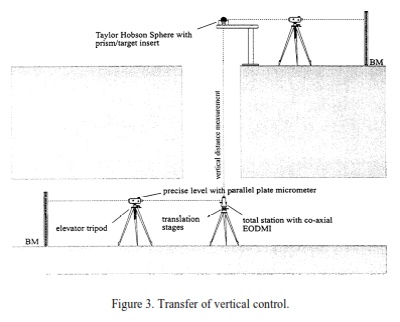

Hydrographic Survey is related to the measurement of distribution and movement of big volumes of water on Earth surface. It mainly measures the tides of sea-water, quantity and quality of protective works of coasts and harbours, determination of depth of water-bodies by sounding, measurement of discharge-quantity and velocity of river-water, determination of scouring, silting and irregularities of river-bed, hyd. survey of sea-shore and MSL, preparation of navigation charts, planning of hydro-electric projects, and planning of dams, reservoirs, bridge-foundations, irrigation, water supply, flood control, river erosion, land reclamation, soil conservation, water-shed management, sewage disposal, etc. Hydrographic Horizontal Control: A single horizontal control survey is required and sufficient for the above-mentioned surveys. This survey consists of a series of connected lines whose lengths and azimuths i.e. WCBs are determined. For extended survey work, Triangulation System is required to be established. The type of horizontal control to be used is decided by the general topography, vegetation, size of water i.e. depth, extent, length of coast-line, etc. For example, if the body of water is more than 1 km in length or breadth, then two traverses along each shore is essential. If the body of water is narrow and its depth is more e.g. rivers, canals, streams, etc then one traverse line along the bank is sufficient. When the vegetation or similar factor is to be considered, then triangulation system is required. For oceans and large lakes, horizontal control consists of network of triangulation system.
: Vertical Control is required to find out the depths of water bodies for navigation and sub-marine voyage. Measurement of depth of water below the water surface level is carried out by the method of Sounding. The method is based on the Echo-sounding (also called Transducing); the equipment is called Echo-Sounder or Transducer; it is an electro-acoustic instrument. Before recording the depth of water, it is advisable to select the vertical control points. BMs of known elevation are established to serve the vertical control points. These BMs are located near the sea-shore at close spacing. Datum of all this survey work will be the MSL. MSL is determined by taking the hourly observations extending over the period of 15 to 20 years. Procedure to establish the datum is: A water-area to be measured known as ‘Guaged Site’ is selected in that area which is free from the rough tidal waves and where the water surface or uniformity of water is not affected by the local conditions.Zero of the guage is taken as a permanent point on-shore to serve as a BM.Elevation of water surface is read regularly over the period of 15 to 20 years.The average of these readings is taken as MSL.
Shore Line Survey: It is carried out for the following purpose:To delineate the Shore-line.To determine the high and low water tides.To locate the prominent points on shores, for certain activities / observationsShore Line Survey: Plane Table and tape or chain are used for delineation or mapping of the shore-line. Permanent and clearly visible objects like temples, churches, light-houses, wind-mills, high-tension towers, etc in that locality are selected as reference points. High and low water levels are marked on the permanent, strong and resistant vertical rocks. Low water line (which is located under-water most of the time) is usually established by sounding.Theory of Tides: High and low water tides are the result of alternate rise and fall of water surface mainly caused by the gravitational attraction of sun (called Solar Tides) and moon (Lunar Tides) on the body of water and minorly by the gusts of wind. The main concept of this theory comes from the Newton’s Equilibrium
Theory of Tides basically based on Coulomb’s Law of attraction between the heavenly bodies, most firstly explained by Galileo in 1616 AD. Tide Gauges: Types: (i) Non-registering Guages (ii) Self Registering Guages.Sounding, Sounding Operation and Equipment: Depth D of the water is calculated from the following relation: D = C x (t1 + t2) / 2 where C is the velocity of sound in the water (it is universally taken as 1470 m/sec, for water) and t1 is the time of transmission and t2 is the time of reception of sound signal.Measurement of Water Discharge of River, Canal or Stream: It is known as Hydrometery
. It was firstly developed by a French Engineer Henry De Pitot in 1732, by inventing “Pitot Tube” to measure the velocity of water in the rivers. A number of methods and equipment are used in this concern. Measurement of Water Discharge of River, Canal or Stream:
Current Meter Method and Apparatus is mostly used to measure the average velocity of the river’s water. Float Method: Used to measure the Surface Velocity of the river’s water. Dilution Technique (also known as Tracer Technique): NaCl or some radio-active substance is used to find out the rate of the said sample to get completely mixed (diffused) with the flow of water to determine the Turbulence of water. Slope Area Method: Used to find out the slope S of water surface of river. S = HL/LWhere HL is vertical difference between the two levels of water surface and L is the horizontal length over which the said two levels are observed. Discharge of the Water Q is calculated from Manning’s famous equation: Q = AV = A. 1 [(A) S1/2] 2/3 n [ P ]Where A is the cross-sectional area, V is the cross-sectional average velocity, P is the wetted perimeter, S is the slope of hydraulic gradient and n is the Manning’s Coefficient (developed by a British Engineer “Robert Manning” in 1890).
Tidal Current Measurement: Velocity and Direction of the Tidal Current are required to measure. Points are established for the discharge of the sewage to the sea to ensure that the sewage is carried sea-ward. Float Method is used; it is used to measure the velocity of the surface current of the sea. This Float Method is different from the Float Method mentioned (above) for the rivers because the Float used in the sea is affected by the surface currents, winds and tidal waves. So in this situation, Rod Float or Double Float is used to overcome the above-said problems.



